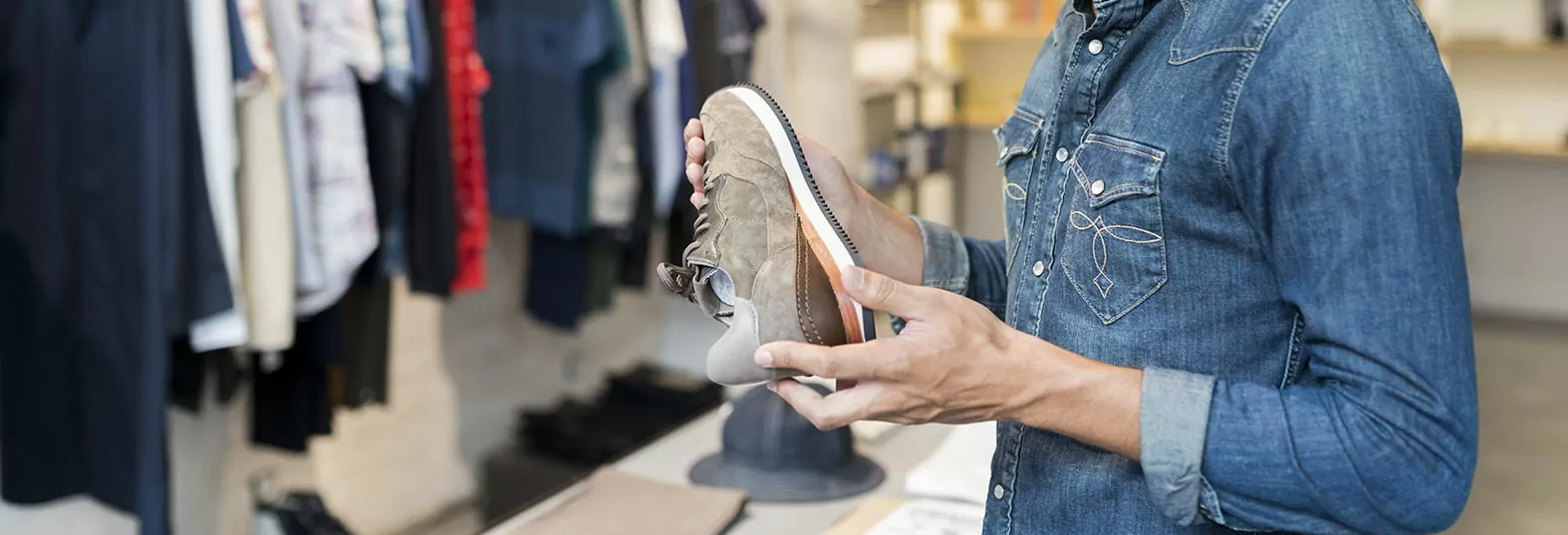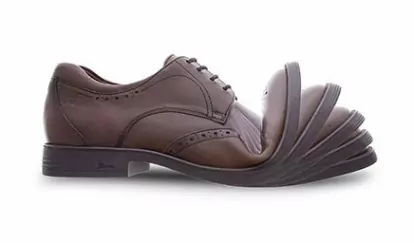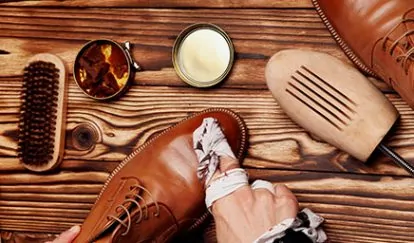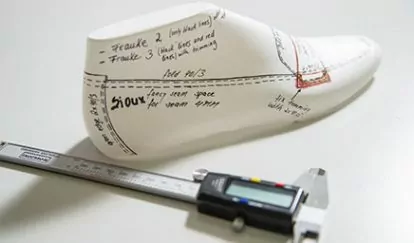THINGS YOU SHOULD CONSIDER WHEN BUYING SHOES
10 practical tips for your next shoe purchase

The following 10 tips will give you a practical guide and help you with your next shoe purchase. Besides the right shoe size and width, an optimal fit, skilful workmanship and the use of high-quality materials for the upper, lining and outsole are also important factors when it comes to quality and selection. We want you to stay feeling comfortable in your shoes for as long as possible.
1. We will start with the most important piece of advice:
The shoes should conform to the shape of your feet, and not the other way around. Consequently, a new shoe should fit your foot perfectly in terms of length and width. Most importantly, your toes need sufficient space (they move up to 0.5 cm due to the roll-through movement when walking). That’s not the case for the heels, which must be firmly supported. Having firmly supported heels is one of the most important factors to ensure a perfectly fitting shoe.
2. Many people buy shoes which do not fit properly:
According to studies conducted by the German Shoe Institute (part of the Association of German Shoe Manufacturers, of which we are also a member), almost 80 per cent of the German population buy shoes which do not fit properly. That is an unbelievably high figure. Whilst women have the tendency to buy shoes which are too small, men are more likely to buy shoes which are too big. This is a real no go.
3. Keep your expectations high:
Shoes should be made of soft leather, wherever possible, and provide your feet with sufficient room – in all three dimensions: height, width and length. As soon as a shoe starts to rub, you know it is not the right one for you. Do not fall for the classic lines “they will wear in” or “they will widen over time”. A pair of shoes should fit perfectly straightaway or you should not buy them. Your owe it to your feet!
4. Take your time when buying shoes:
You should also check the inside of the shoes for any seams that may be uncomfortable, or any bulges or hardened areas. Many shoe manufacturers do not fully line their shoes in order to reduce costs, i.e. the lining ends at the area which is not visible, for example. As a result, seams, bulges and edges are exposed. Here, at Sioux, we make it our standard to always fully line our shoes and to stitch together large sections as far as possible. This is how we avoid unnecessary seams and edges which could restrict the level of comfort when worn. Larger pieces of leather, however, are more costly, which is why we do not produce low-cost shoes, but rather high-quality shoes that are worth every penny you pay for them.
5. A flexible shoe sole is a must:
When you have got the size and width right, you should turn your attention to the softness of the leather and a flexible shoe sole. Flexible means the ability to bend. Lots of people mix up the flexibility of the sole and the softness of the inner padding . Therefore, you should do the ‘bending’ test. If you bend the shoe (i.e. bend the heel and the toe area towards each other) and the soles takes a V form, then the shoes have exemplary flexibility.
6. Keep them as flat as possible:
Another recommendation that we have already given is to purchase shoes which are as anatomically and orthopaedically flat as possible. The roll-through movement of the foot can only take place as naturally as possible in flat shoes, as there is no improper weight distribution at the arch of the foot and the metatarsal bones. We do not want to spoil your fun: when it comes to high heels, wear them in moderation and only as long as foot exercises and movement strengthen the foot muscles, meaning that your feet can withstand the strain of the high heels. It is important to have a balance between this style of footwear and everyday, comfortable footwear.
7. Try on both shoes:
Feet are almost never the same length and width. Right-handed people usually have a dominant right foot, which is the bigger of the two. This is the opposite for left-handed people. That is why you should always try on both shoes and not just one. What’s more: shoes become longer and wider with age. Consequently, the shoe size can change with age, which is why you should be open-minded when buying shoes. If a shoe fits, it doesn’t matter if it is a size larger or wider than the previous pair. Shoes made from different manufacturers turn out differently sized. What matters is how it feels on your own, individual foot.
8. The time of day is important:
Your feet change in size and shape depending on the time of the day, particularly on hot summer days, when swelling can occur. It is therefore best to buy shoes in the evening and jog a little beforehand so that your feet reach a “working temperature” before trying on shoes so that they have swelled slightly.
9. Pay attention to the leather finishing:
You shouldn’t disregard whether the shoe is made of a synthetic material or leather. Humans release around 0.1 cl (i.e. a shot glass) of perspiration from their feet each day. It is therefore imperative that the shoe is breathable and can absorb moisture. Leather is a natural product with distinctive material properties. No other material is as flexible and can absorb and release moisture so effortlessly. Here, at Sioux, we either fully line our shoes with a real leather lining (90% of shoes) or with a breathable microfibre (part of the canvas Grashopper features this lining). This leads to a healthy foot climate and counteracts sweaty feet.
10. Know whether or not to trust the manufacturer:
It is not just the workmanship of the shoe which is important, but also which materials the manufacturer uses and under which conditions the raw materials have been processed, i.e. tanning of the leather and workmanship involved in manufacturing the shoe. Consumers are becoming increasingly conscious of the origin and sustainability of their leather. And rightly so. However, on the other hand, it is becoming increasingly difficult for a consumer to guarantee the quality of their leather. Nowadays, faux leather is becoming so much more refined that only experts are able to tell the difference between this and genuine leather. German brand manufacturers such as Sioux guarantee excellent quality and compliance with all statutory social and environmental standards with their good name. We have been making shoes, and nothing but shoes, for over 60 years now. Every one of our shoes is finished with expert know-how, craftsmanship and a loving touch.
OUR PRODUCT RECOMMENDATIONS FOR YOU
Shoe construction techniques
Why are there so many different shoe models? The construction technique used by Sioux depends on what the shoe will be worn for and what the wearer requires from it. Because, ultimately, the shoe must have a perfect fit.
Things you should consider when buying shoes
The following 10 tips will give you a practical guide and help you with your next shoe purchase. Besides the right shoe size and width, an optimal fit, skilful workmanship and the use of high-quality materials for the upper, lining and outsole are also important factors when it comes to quality and selection. We want you to stay feeling comfortable in your shoes for as long as possible.
Crepe sole
Learn more about what is undoubtedly the most natural form of comfort - everything about this Sioux speciality can be found here.
Labelling of materials
A question frequently asked by our customers is: “How can I be sure that the material used is really genuine leather?"
The history of footwear
More than 40,000 years ago, people developed a need to protect their feet against adverse external conditions. It took several centuries, however, until the fashionable and comfortable footwear that we are familiar with today became available.
Sioux hallgus protect
The combination of high-quality leather and our innovative Sioux-Tex climate membrane will give your feet that “feel-good” feeling: whilst moisture and vapour are quickly wicked away from the shoes, water from the outside has no chance of getting in, meaning your feet are always warm and dry.
Sioux natural move system
The combination of high-quality leather and our innovative Sioux-Tex climate membrane will give your feet that “feel-good” feeling: whilst moisture and vapour are quickly wicked away from the shoes, water from the outside has no chance of getting in, meaning your feet are always warm and dry.
SiouxTex
The combination of high-quality leather and our innovative Sioux-Tex climate membrane will give your feet that “feel-good” feeling: whilst moisture and vapour are quickly wicked away from the shoes, water from the outside has no chance of getting in, meaning your feet are always warm and dry.
Shoe lining
Consumers often only pay attention to whether they like a shoe and whether it fits well. What is inside the shoe should also be a decisive factor: the shoe lining is often underestimated when buying shoes, despite being a key factor when it comes to comfort and health. Below we will explain the various types of shoe lining, their uses and the importance of shoe lining when it comes to your well-being.
Shoe soles
Whether they are a lightweight and flexible, feature unique air-cushioning or have a timeless and elegant leather sole: it's the perfect join of the shoe upper and sole which is the finishing touch to each and every shoe.
Shoe size and fit
As the foot performs a rolling motion when walking, it bears your weight in various areas and thus changes shape in doing so. The hallmark of a perfect-fitting shoe is that the toes and the foot itself have enough space within the shoe throughout this rolling motion and that the heel experiences sufficient grip. When a shoe fits, the heel does not slip out of the back of the shoe, and the shoe sits so perfectly in the midfoot area that the foot is supported – and is unable to slip forwards – hence the shoe pinching.
Shoe leather
Choosing the leather is very easy when it comes to Sioux shoes: we only settle for the best.
Shoemaking
There are lots of steps involved in making a shoe. From developing the model in the first instance, to the stamping, sewing and putting the finishing touches to the shoe at the very end.
Grashopper
In the 1960s, the natural form moccasin was a revolution. Today, the cult shoe is more topical than ever as a pioneer in modern casual wear.
 DE
DE EN
EN FR
FR NL
NL















